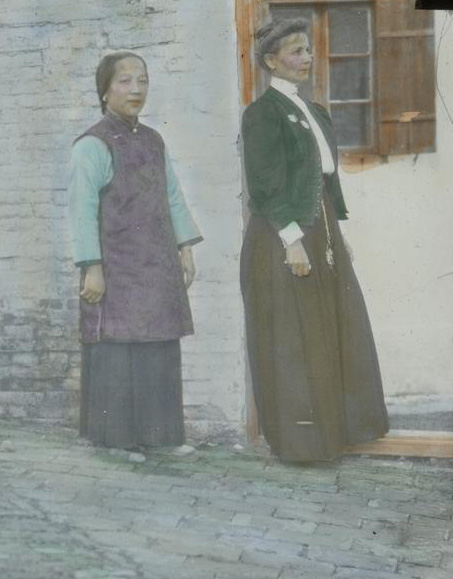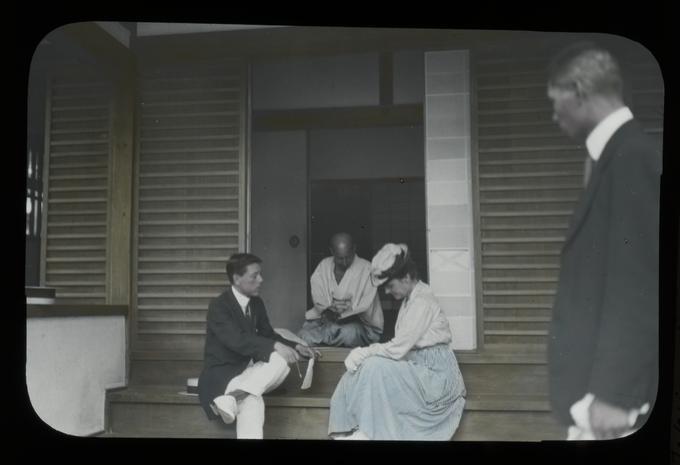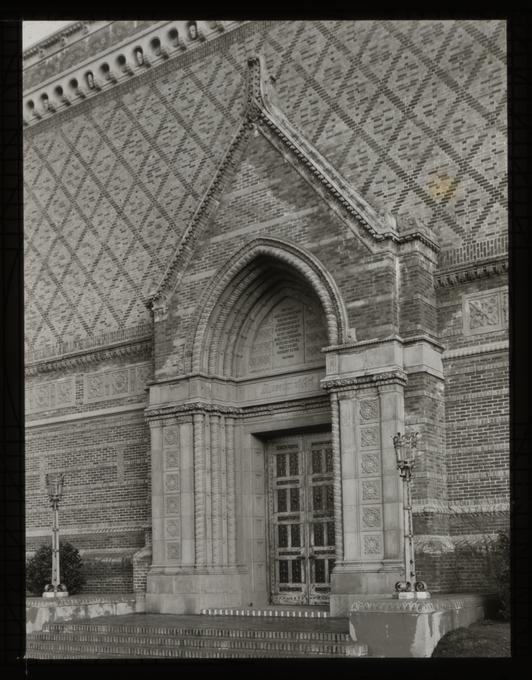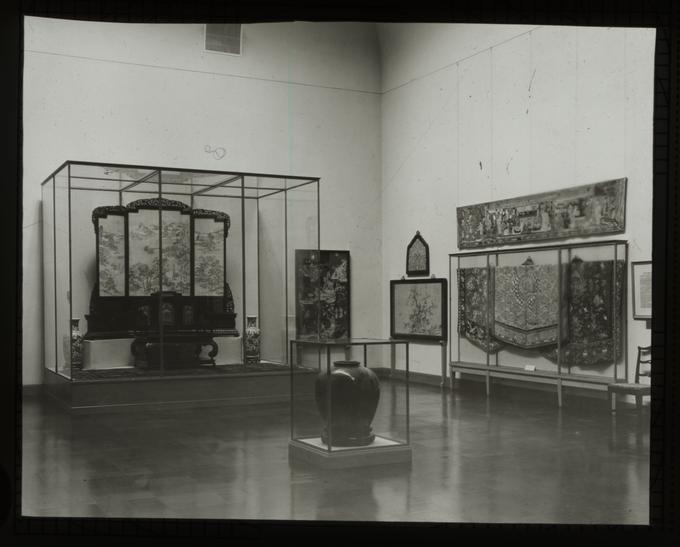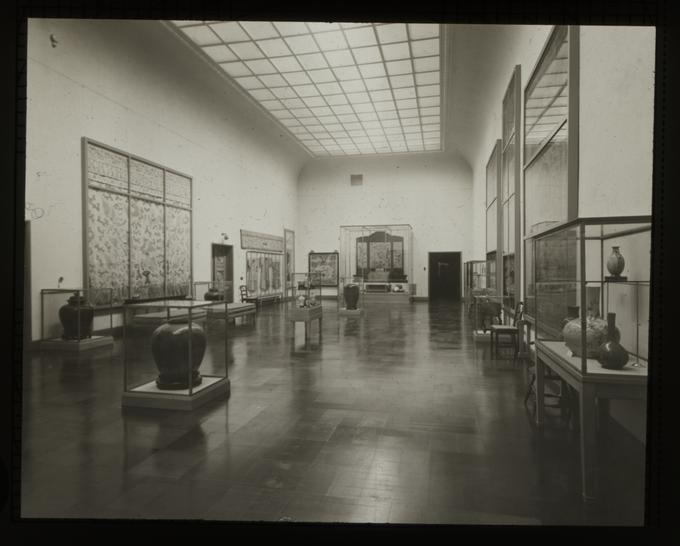Gertrude Bass Warner was a world traveler, art collector, museum specialist, and scholar of Shinto rituals who established the University of Oregon Museum of Art—the first museum in Oregon devoted to Asian art. As the museum’s founding director and curator from 1933 to 1951, she promoted the understanding of Asia through access to its visual and material culture.
Born in Chicago on May 14, 1863, Gertrude Bass spent five years of her childhood in Europe, including Switzerland, France, and Italy. Her father, attorney and real estate developer Perkins Bass, was president of Illinois State Normal University (1861–1862) and was appointed U.S. District Attorney for Northern Illinois by President Abraham Lincoln in 1864. Warner later credited her father for stimulating her early interest in art and cross-cultural understanding. She attended boarding schools in Philadelphia and Paris and studied art and photography at Vassar College for a year until her marriage to Dr. George Foster Fiske of Chicago in 1888. The couple had three children and divorced in 1894.
Warner traveled to Asia in 1904 with her older brother, John Foster Bass, a journalist covering the Russo-Japanese War for the New York Herald. She established a residence in Shanghai, which had a large expatriate population. There she met Major Murray Warner, an American engineer who had worked for the Shanghai Volunteer Corps. The couple married on October 1, 1905, and the family remained in China until 1909.
Among Gertrude Warner’s activities in China was the cultivation of silkworms, which she crossbred to achieve various colors of thread. Her interest in sericulture and its customs as a predominantly female labor practice extended to Warner’s acquisition of status garments, folk textiles, and other fiber arts. She also studied Chinese and Japanese social customs, acquired works of art in a wide variety of media, and traveled with visiting artists, including Charles W. Bartlett, Helen Hyde, Bertha E. Jacques, Elizabeth Keith, Maude Kerns, and Bertha Lum. Her cultural studies and observations during extended travels in Japan in 1918–1919 informed her unpublished manuscript, “When East Meets West.” She amassed an extensive library and over five thousand lantern slides of rural and urban scenes, some taken by Warner and her family but most shot by commercial photographers. The family traveled around the region on their houseboat, The Illinois. After leaving China, the couple established a home in San Francisco.
Following her husband’s death in 1920, Warner moved to Eugene, where her son Sam Bass Warner was a professor at the University of Oregon Law School. She donated her art collection to the university in 1921, and the Board of Regents named her “curator for life.” The collection included more than 3,700 objects, primarily from China, Japan, Korea, Mongolia, Cambodia, and Russia. The Murray Warner Collection of Oriental Art was housed in Gerlinger Hall while funds were raised for a new museum building. The project’s architect was Ellis F. Lawrence, dean of the UO School of Architecture and Allied Arts. Warner advised Lawrence on security, climate and humidity levels, and installation requirements.
Ground was broken for the University of Oregon Museum of Art in September 1929; construction was completed in 1930. Before approving public access to the museum, Warner demanded that additional measures be made to safeguard the collection, such as reducing light exposure to objects and ensuring proper art handling and display practices. The building was dedicated on June 11, 1932, with an official opening on June 10, 1933. The courtyard was named in honor of Prince Lucien Campbell, the university’s fourth president, who was Warner’s close collaborator prior to his death in 1925.
During Warner’s six trips to Asia between 1921 and 1933, she acquired additional Chinese and Japanese artworks to expand the museum’s holdings. She also founded an East Asian Studies Department at the university, one of the first of its kind in the United States. Her deep interest in Shintoism—particularly its rituals, processions, and shrines—are reflected in her notes and several unpublished manuscripts.
In 1929, Warner received an honorary Master of Arts in Public Service from the University of Oregon in recognition of her scholarly contributions and her “tireless efforts in the promotion of international good will.” Until her death at the family’s home in in Hillsborough, New Hampshire, on July 29, 1951, she oversaw the museum’s collections, exhibitions, and research library, often financing training and educational travel for staff.
The museum, which is on the National Register of Historic Places, was renamed the Jordan Schnitzer Museum of Art in 2005 when the original building was renovated and enlarged. Selected works from Warner’s collection are exhibited at the JSMA or loaned to accredited museums, in addition to being made available for academic access to support the University of Oregon’s educational mission.
-
![]()
Gertrude Bass Warner with an unknown woman, Japan..
Courtesy University of Oregon Libraries -
![]()
Gertrude Bass Warner, Kyoto, Japan.
Courtesy University of Oregon Libraries -
![]()
Jordan Schnitzer Museum of Art (then the U.O. Museum of Art), Eugene.
Courtesy Gertrude Bass Warner (1863-1951) photographs, University of Oregon. "PH014_b090_053 Gertrude Bass Warner photographs" Oregon Digital -
![]()
Jordan Schnitzer Museum of Art (then the U.O. Museum of Art), Eugene.
Courtesy University of Oregon Libraries
Related Entries
-
![Ellis F. Lawrence (1879-1946)]()
Ellis F. Lawrence (1879-1946)
Portland architect Ellis Fuller Lawrence was the leading organizer of h…
-
![Jordan Schnitzer Museum of Art]()
Jordan Schnitzer Museum of Art
The Jordan Schnitzer Museum of Art (JSMA), situated on the Memorial Qua…
Map This on the Oregon History WayFinder
The Oregon History Wayfinder is an interactive map that identifies significant places, people, and events in Oregon history.
Further Reading
Fitzgerald, Joshua. Warner and the World (blog). Eugene: University of Oregon, June 2017.
Fong, Lawrence M., et al, Precious Cargo: The Legacy of Gertrude Bass Warner. Eugene: University of Oregon, 1997.
Gertrude Bass Warner papers, 1879-1954 (includes Warner's unpublished manuscript, “When West Meets East," and her collection of lantern slides), University of Oregon Special Collections & University Archives, Eugene, Oregon.
Koehler, June Irene, and Megan Lallier-Barron. Through Her Lens: Gertrude Bass Warner’s Vision of Asia. Eugene, Ore.: Jordan Schnitzer Museum of Art, 2013.
Richard, Keith. “The Stormy Birth of a Museum.” Old Oregon (Summer 1982): 13-17.



